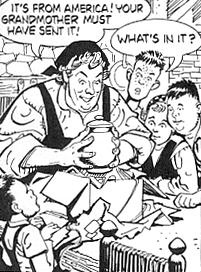Legend: A foreign family unknowingly consumes the ashes of a relative shipped to them for burial.
Example: [De Vos, 1996]
When the family moved to North America, they kept in constant touch with their European relatives. Letters and parcels regularly made their way from one shore to another. After a long period of silence, a small box arrived from the U.S. Inside, carefully wrapped in tissue paper, was a jar of grey powder. There was no note, but since many of the previous parcels had contained ready-to-make packaged mixes, the European family members thought that this powder, too, was a mix that would be prepared by simply adding water. The sauce was made and served, but it wasn't the best they had eaten! Several days later, a letter arrived from the U.S. explaining that the father had died, and because he had always been homesick, he wished his ashes to be spread over his home town. Grandma hoped that the rest of the family would not be inconvenienced and that the letter would get to them before the ashes, which were being sent separately in a jar and were securely wrapped in tissue paper. |
Variations:
- The relative's remains are usually shipped in an urn mistaken for an ordinary jar by the recipients, but in many versions of this legend the confusion is caused by the ashes' having been packaged in some sort of makeshift container such as a small box or a re-used food container such as a cocoa tin.
- The food item for which the remains are mistaken varies: an instant drink; a condiment, spice, or sauce mix (generally served with meat), flour (baked into bread or cake), powdered soup, or even dried coconut.
- The explanatory letter does not arrive in time because it is mailed separately several days after the ashes are shipped (sometimes due to post office regulations that prevent letters from being sent inside packages), or because it is posted at the same time as the package but gets delayed in transit. Other versions feature an identifying letter that accompanies the remains but is written in a foreign language, and the family eats the remains before the letter is translated.
Origins: This

tale has circulated both as a legend and as a joke, and it features several themes common to both: unwitting consumption of a disgusting substance, disaster caused by unfamiliarity with modern technology, and humorous mishaps initiated by unsophisticated ethnic "rubes." It was widespread in the years just after the end of World
As folklorist Charles Clay Doyle has noted, this legend is similar to a grim bit of anti-semitic humor dating from the Renaissance, in which an Italian Jew attempts to smuggle the corpse of a friend home to Venice for burial (an illegal act at the time) by packing the dismembered body in a jar with spices and honey. During the boat trip back to Italy, a gentile passenger mistakes the substance in the jar for a delicacy and eats portions of it.
Sightings: This legend forms the plot of a 1972 one-act play by Pat Wilson titled Funeral Tea.
Last updated: 21 February 2009
 Sources:
Sources:
 Also told in:
Also told in:Fiery, Ann. The Complete and Totally True Book of Urban Legends. Philadelphia: Running Press Books, 2001. ISBN 0-7624-107404 (pp. 68-71). Healey, Phil and Rick Glanvill. Now! That's What I Call Urban Myths. London: Virgin Books, 1996. ISBN 0-86369-969-3 (pp. 226-227). Holt, David and Bill Mooney. Spiders in the Hairdo. Little Rock: August House, 1999. ISBN 0-87483-525-9 (p. 76).
The Big Book of Urban Legends.New York: Paradox Press, 1994. ISBN 1-56389-165-4 (p. 71).
